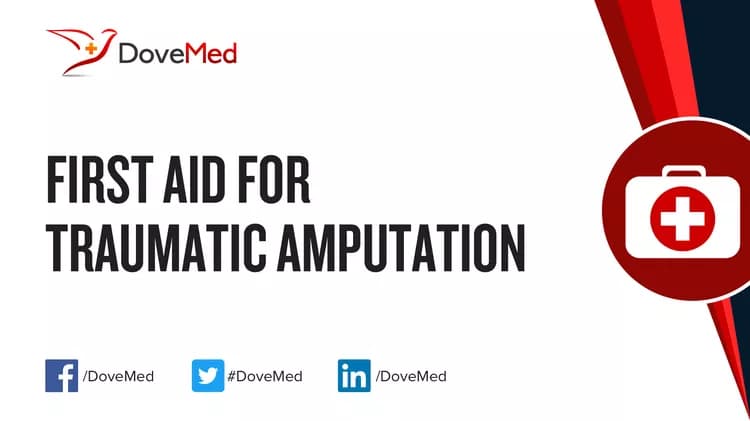What is Traumatic Amputation?
- A Traumatic Amputation may be described as a severe injury that results in the severing (cutting-off) of a body part, such as a finger, toe, arm, or leg
- The condition may be partial (when the part is still attached to the body) or total (when the severed part is completely detached from the body)
- The condition is a medical emergency that needs to be addressed immediately
What are the Causes of Traumatic Amputation?
Traumatic Amputations are caused by a variety of factors including:
- Industrial accidents while working with certain equipment and tools
- Assaults due to street fights (knife attacks), domestic violence
- Automobile or vehicular accidents
- Falling of heavy and sharp objects
- Hands or fingers getting jammed in metal or heavy doors and windows
- Use of arms and armaments (explosive devices, land mines)
- Terrorist attacks; injuries sustained in war and combats
What are the Signs & Symptoms of Traumatic Amputation?
The signs and symptoms of a Traumatic Amputation depend on the severity and location of the injury, and they may include:
- Severe emotional stress and trauma
- Moderate to severe bleeding depending on the site and extent of injury
- Shock; unconsciousness
- The amputation may be partial or complete (when the body part is completely detached from the body)
- If the accident involved sharp instruments or tools, then the amputation may not involve crushed bones and tissue
- If the accident was due to brute and blunt force or explosions, then there may be crushed body part(s), bones, and tissue
- In many cases, the involved part is a finger, toe, hand, or leg
- Mild, moderate, or severe pain; it is often seen that the pain may not be directly proportional to the severity of the injury
- Multiple body parts or systems may be affected
How is First Aid administered for Traumatic Amputation?
First Aid tips for Traumatic Amputations include:
- Calling 911 (or your local emergency number) immediately
- If the individual is still trapped in the accident spot, try to move or remove the individual from the spot as safely as possible; else, wait for the first responders
- Try to keep the injured individual calm and comforted (to the extent possible)
- In case of an injury to the head, neck, back, or spine, try to immobilize the individual and avoid movement
- Ensure that the individual can breathe normally; else, administer CPR
- By applying direct pressure to the wound or injury, try to control the bleeding
- If arterial bleeding is suspected and medical assistance is not immediately available, use of a tourniquet may be appropriate
- Use a tight bandage when the bleeding is not stopping; however, this procedure should be done in a manner that it does not aggravate the condition
- Retrieve the severed body part and clean the severed end using water (if it is dirty)
- Place it in a wet clean cloth and wrap it carefully
- Following this, place the amputated part in a plastic bag and seal it
- Place the plastic bag containing the severed part in ice-cold water (and NOT in ice)
- Keeping the amputated part cool helps in easier surgical reattachment
- DO NOT place the severed body part directly in contact with water or ice
- DO NOT expose the severed body part to hot water or sunlight
- DO NOT try to manipulate the injury site, injured limb/part in any manner
- Avoid giving false hopes to the victim
- Make the affected individual to lie down on a flat surface and cover with a blanket; however, keep the legs slightly elevated (by about a foot or 30 cm)
- In case of other serious injuries, those need to be addressed suitably as well. In some cases, such injuries may be life-threatening and may require urgent attention
- Take the individual to emergency room (ER) for further treatment, as quickly as possible
Who should administer First Aid for Traumatic Amputation?
- Any individual, in close vicinity of the injured person, can provide immediate comfort and first aid
- Calling 911 (or your local emergency number) is the first and most crucial step
What is the Prognosis of Traumatic Amputation?
- The prognosis for a Traumatic Amputation varies widely and depends on:
- The body part(s) involved and the extent of injury
- Severity of the trauma associated with the condition
- Time elapsed between the amputation incident and treatment
- Minor cases have a much better prognosis than moderate to severe Traumatic Amputation cases. It may be possible to reattach the severed body part in some cases. If it is not possible to reattach the amputated part, the affected individual may require the aid of a prosthetic device
- In case of severe injuries, delayed treatment, severe traumatic shock, the prognosis may be guarded. It can result in permanent injuries, impairment, or even be fatal
How can Traumatic Amputation be Prevented?
A few helpful tips to prevent Traumatic Amputations:
- Utilize suitable PPE (personal protective equipment) while performing certain dangerous activities, outdoor activities, or sports
- Be extremely careful while handling explosive substances, mines etc.
- Use seatbelts in motor vehicles
What are certain Crucial Steps to be followed?
- Immediately call 911 or your local emergency number
- Find the severed part and keep it safe and secure (per above recommendations)
- Do NOT attempt to move any individual with a suspected head, neck, or back injury; or, if you suspect a broken hip or pelvis
Related Articles
Test Your Knowledge
Asked by users
Related Centers
Related Specialties
Related Physicians
Related Procedures
Related Resources
Join DoveHubs
and connect with fellow professionals


0 Comments
Please log in to post a comment.